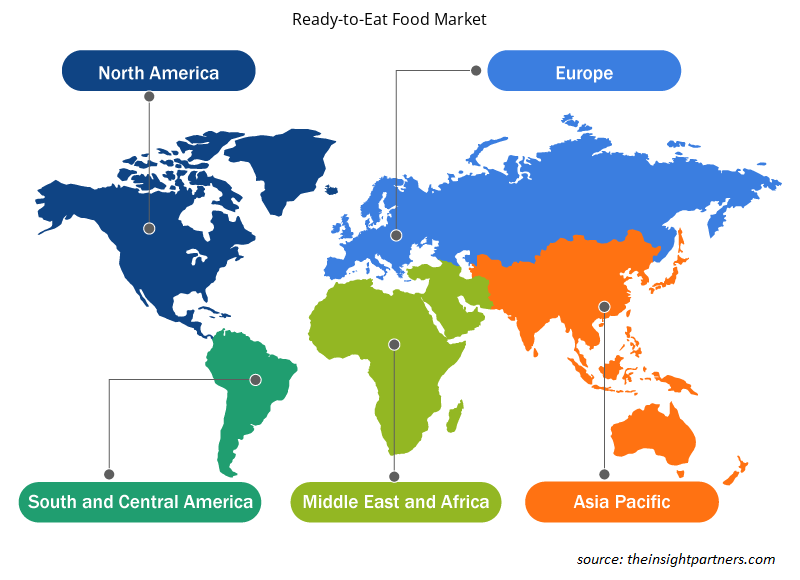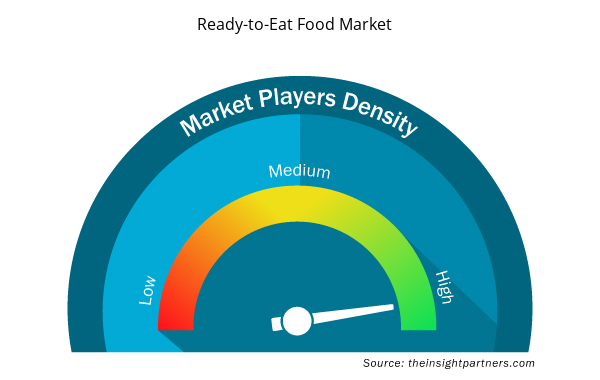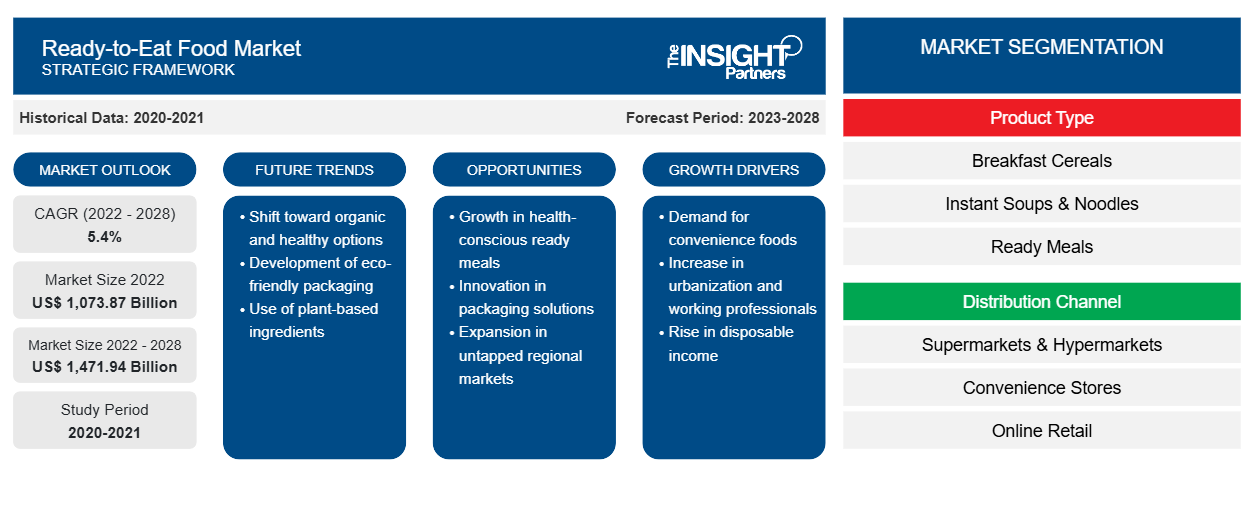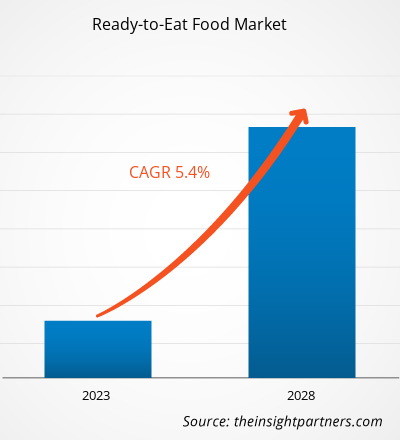[調査レポート] 調理済み食品市場は、2022年の1兆738億7000万米ドルから2028年には1兆4719億4000万米ドルに達すると予測されています。2022年から2028年にかけて5.4%のCAGRで成長すると予想されています。
調理済み食品は、追加の準備なしで食べられるさまざまな加工食品や包装食品で構成されています。原材料は洗浄、調理、加工され、直接食べられるよう容器に詰められます。RTE 食品の一般的なタイプには、インスタント スープ、焼き菓子、デザート、調理済み食品などがあります。これらの製品には、さまざまな抽出物、酸、香料、甘味料、抗酸化物質、保存料が豊富に含まれています。これらは消費者に非常に便利であると同時に、食事の準備時間を短縮し、製品の保存期間を延ばし、コスト効率を高め、腐敗を最小限に抑えます。
2020年、アジア太平洋地域は調理済み食品市場で最大のシェアを占めましたが、中東やアフリカなどの他の発展途上地域も予測期間中に大幅に成長すると予想されています。調理済み食品市場で活動する主要企業は、発展途上国の労働人口の増加と人々の多忙なライフスタイルにより、アジア太平洋地域全体で事業を拡大しています。個人は、外出先や自宅外での食事を選択することが増えています。
さらに、多くの研究により、多国籍食品飲料企業 (TFBC) が食品システムと一般消費に影響を与え、加工食品の入手可能性、望ましさ、価格、そして最終的には消費を変えてきたことが明らかになっています。中所得国では、調理済み食品市場の成長が顕著に見られます。
要件に合わせてレポートをカスタマイズする
このレポートの一部、国レベルの分析、Excelデータパックなど、あらゆるレポートを無料でカスタマイズできます。また、スタートアップや大学向けのお得なオファーや割引もご利用いただけます。
- このレポートの主要な市場動向を入手してください。この無料サンプルには、市場動向から見積もりや予測に至るまでのデータ分析が含まれます。
COVID-19パンデミックが調理済み食品市場に与える影響
COVID-19パンデミックは、2020年初頭に多くの分野に前例のない課題をもたらしました。WHOと各国保健省のガイドラインに従って政府が実施したロックダウン、国境規制、渡航禁止、製造中止、その他の安全対策により、製造業務が妨げられました。一方、COVID-19の発生は、消費者と小売業者が陳列棚の長いインスタント食品を買いだめしていたため、調理済み食品市場にはプラスの影響を与えました。また、免疫力を高めるためにより健康的な包装食品や飲料製品を求める消費者は、COVID-19の影響に警戒していました。その後、RTE製品メーカーは、タンパク質やその他の栄養価を強化した健康的で栄養価の高い製品に焦点を合わせ、パンデミック中に調理済み食品の需要を刺激しました。
市場洞察
ミレニアル世代のインスタント食品への強い嗜好が市場の成長を牽引
高品質のインスタント食品の消費が増加しており、これは現在、食品業界における最大のトレンドの 1 つです。RTE 製品などのインスタント食品により、消費者は食事の準備や調理、消費、食後の活動に関連する時間と労力を節約できます。この食品セグメントの発展の源には、数多くの社会的変化、特に小規模世帯の増加と世界中のミレニアル世代の人口の増加が含まれると言われています。ミレニアル世代は仕事が忙しいため、退屈な作業に時間を浪費するよりも効率的に時間を活用したいと考えています。彼らは利便性のためにお金を使う可能性が高くなります。そのため、焼き菓子、スナック、乳製品などの RTE 製品がますます好まれるようになり、すぐに食べられる食品市場をさらに牽引しています。
製品タイプの洞察
製品タイプに基づいて、調理済み食品市場は、朝食用シリアル、インスタントスープと麺、調理済み食事、スナック、焼き菓子と菓子、その他に分類されます。その他の調理済み食品セグメントは、予測期間中に最大のシェアを記録すると予測されています。その他のタイプには、乳製品、デザート、スプレッド、ソース、ディップなどがあります。RTE乳製品には、アイスクリーム、ヨーグルト、パッケージ入りフレーバーミルク、チーズなどがあります。健康志向の消費者は、通常の乳製品が骨と腸の健康を改善し、心血管疾患(CVD)と2型糖尿病のリスクを軽減するため、主に乳製品を消費します。人々が伝統的な生活様式から現代的なライフスタイルに切り替えたため、加工およびパッケージ化されたソースとディップの人気が高まり、調理済み食品市場の成長を後押ししました。
調理済み食品市場の地域別分析
予測期間を通じて調理済み食品市場に影響を与える地域的な傾向と要因は、Insight Partners のアナリストによって徹底的に説明されています。このセクションでは、北米、ヨーロッパ、アジア太平洋、中東、アフリカ、南米、中米にわたる調理済み食品市場のセグメントと地理についても説明します。

- 調理済み食品市場の地域別データを入手
調理済み食品市場レポートの範囲
| レポート属性 | 詳細 |
|---|---|
| 2022年の市場規模 | 1兆738億7000万米ドル |
| 2028年までの市場規模 | 1兆4,719億4,000万米ドル |
| 世界のCAGR(2022年 - 2028年) | 5.4% |
| 履歴データ | 2020-2021 |
| 予測期間 | 2023-2028 |
| 対象セグメント | 製品タイプ別
|
| 対象地域と国 | 北米
|
| 市場リーダーと主要企業プロフィール |
|
調理済み食品市場のプレーヤー密度:ビジネスダイナミクスへの影響を理解する
調理済み食品市場は、消費者の嗜好の変化、技術の進歩、製品の利点に対する認識の高まりなどの要因により、エンドユーザーの需要が高まり、急速に成長しています。需要が高まるにつれて、企業は提供品を拡大し、消費者のニーズを満たすために革新し、新たなトレンドを活用し、市場の成長をさらに促進しています。
市場プレーヤー密度とは、特定の市場または業界内で活動している企業または会社の分布を指します。これは、特定の市場スペースに、その規模または総市場価値と比較して、どれだけの競合相手 (市場プレーヤー) が存在するかを示します。
調理済み食品市場で事業を展開している主要企業は次のとおりです。
- ネスレSA
- コナグラブランズ株式会社
- クラフト・ハインツ社
- ゼネラルミルズ社
- キャンベルスープカンパニー
免責事項:上記の企業は、特定の順序でランク付けされていません。

- 調理済み食品市場のトップキープレーヤーの概要を入手
流通チャネルの洞察
流通チャネルに基づいて、調理済み食品市場はスーパーマーケットとハイパーマーケット、コンビニエンスストア、オンライン小売、その他に分類されています。オンライン小売セグメントは、予測期間中に調理済み食品市場で最高のCAGRを記録すると予測されています。オンライン小売は、ユーザーに便利なショッピング体験を提供し、製品の配送が簡素化されます。オンライン小売店は、幅広い製品を大幅な割引価格で提供しています。また、消費者は希望する製品を遠隔地から便利に購入できます。
調理済み食品市場で事業を展開している主要企業は、ネスレ SA、コナグラ ブランズ社、クラフト ハインツ社、ゼネラル ミルズ社、キャンベル スープ社、MTR フーズ社、ホーメル フーズ社、タイソン フーズ社、JBS SA、ケロッグ社です。これらの企業は、新たな消費者トレンドに対応し、規制の枠組みを遵守するために、健康リスクの少ない製品の開発に取り組んでいます。また、合併や買収、事業拡大、提携に携わり、市場シェアを拡大しています。
レポートの注目点
- 即席食品市場における進歩的な業界動向は、プレーヤーが効果的な長期戦略を策定する上で役立ちます。
- 先進国市場と発展途上国市場での成長を確保するために採用された事業成長戦略
- 2019年から2028年までの調理済み食品市場の定量分析
- 調理済み食品の世界需要の推定
- 業界で活動するバイヤーとサプライヤーの有効性を示すポーターの5つの力の分析
- 競争市場の状況を理解するための最近の動向
- 市場動向と見通し、そしてインスタント食品市場の成長を左右する要因
- 商業的利益の基盤となる市場戦略を強調し、市場の成長につながる意思決定プロセスを支援する
- さまざまなノードにおける調理済み食品市場の規模
- 市場の詳細な概要とセグメンテーション、およびRTE製品業界の動向
- 有望な成長機会のあるさまざまな地域の成長規模
- 過去2年間の分析、基準年、CAGRによる予測(7年間)
- PEST分析とSWOT分析
- 市場規模価値/数量 - 世界、地域、国
- 業界と競争環境
- Excel データセット



Report Coverage
Revenue forecast, Company Analysis, Industry landscape, Growth factors, and Trends

Segment Covered
This text is related
to segments covered.

Regional Scope
North America, Europe, Asia Pacific, Middle East & Africa, South & Central America

Country Scope
This text is related
to country scope.
よくある質問
The major players operating in the global ready-to-eat food market are Nestlé SA; Conagra Brands Inc.; The Kraft Heinz Company; General Mills Inc.; CAMPBELL SOUP COMPANY; MTR Foods Pvt Ltd.; Hormel Foods Corporation; Tyson Foods, Inc.; JBS S.A.; The Kellogg Company.
In 2020, Asia Pacific accounted for the largest share of the global ready-to-eat food market. Many Asia Pacific countries, such as China and India, are among the world's fastest-growing populations. The food industry is anticipated to expand at a faster pace as a result of increasing population, rising urbanization, and rapid development of suburban areas. The growing middle class coupled with increasing disposable income in the developing countries of Asia Pacific is expected to result in high growth rate for the region over forecast period.
In 2020, the supermarkets and hypermarkets segment accounted for the largest market share. The penetration of supermarkets and hypermarkets is rapidly expanding globally with big retailers such as Walmart expanding into many developing countries in Asia Pacific. Supermarkets and hypermarkets are one stop shop for numerous ready-to-eat food and offers large discounts due to economies of scale. The convenience and discounts offered by supermarkets and hypermarkets has resulted in dominant share for the segment in the ready-to-eat food market.
On the basis of product type, ready meals is the fastest growing segment. The growing hectic schedules as well as evolving lifestyles has led consumers to increasingly seek ready meals. Moreover, the increasing working women population has led to working households, resulting in less time for meal preparation. Thus, ready meals are increasingly being consumed as they offer convenience.
Rise in working women population is a key driver of global ready-to-eat food market. In Asia, female labor force participation ranges from 16% in Afghanistan to 83% in Nepal, further growing in several other countries in the region. According to the “International Labor Organization,†the female employment rate in Germany was 42.50% in 1990 and has increased to 54.91% by 2020. Similarly, the female employment rates in other countries such as the US, France, Chile, and Mexico have surged in recent times.
Innovations in RTE products and strategic developments by manufacturers is expected to offer lucrative opportunities in the market. Major manufacturers are employing creative strategies such as new product releases and production capacity scaleup to better serve their customers and satisfy their growing demands. In May 2018, Del Monte Foods, Inc., a prominent processed food company, launched a canned Gold Pineapple line with a major focus on teenagers as a target consumer group. Major RTE product manufacturers are collaborating and partnering with other market players to launch innovative products in the market. The aforementioned factors have led to increased opportunities for ready-to-eat food market.
Trends and growth analysis reports related to Food and Beverages : READ MORE..
The List of Companies - Ready-to-Eat Food Market
- Nestlé SA
- Conagra Brands Inc.
- The Kraft Heinz Company
- General Mills Inc.
- CAMPBELL SOUP COMPANY
- MTR Foods Pvt Ltd.
- Hormel Foods Corporation
- Tyson Foods, Inc.
- JBS S.A.
- The Kellogg Company
The Insight Partners performs research in 4 major stages: Data Collection & Secondary Research, Primary Research, Data Analysis and Data Triangulation & Final Review.
- Data Collection and Secondary Research:
As a market research and consulting firm operating from a decade, we have published and advised several client across the globe. First step for any study will start with an assessment of currently available data and insights from existing reports. Further, historical and current market information is collected from Investor Presentations, Annual Reports, SEC Filings, etc., and other information related to company’s performance and market positioning are gathered from Paid Databases (Factiva, Hoovers, and Reuters) and various other publications available in public domain.
Several associations trade associates, technical forums, institutes, societies and organization are accessed to gain technical as well as market related insights through their publications such as research papers, blogs and press releases related to the studies are referred to get cues about the market. Further, white papers, journals, magazines, and other news articles published in last 3 years are scrutinized and analyzed to understand the current market trends.
- Primary Research:
The primarily interview analysis comprise of data obtained from industry participants interview and answers to survey questions gathered by in-house primary team.
For primary research, interviews are conducted with industry experts/CEOs/Marketing Managers/VPs/Subject Matter Experts from both demand and supply side to get a 360-degree view of the market. The primary team conducts several interviews based on the complexity of the markets to understand the various market trends and dynamics which makes research more credible and precise.
A typical research interview fulfils the following functions:
- Provides first-hand information on the market size, market trends, growth trends, competitive landscape, and outlook
- Validates and strengthens in-house secondary research findings
- Develops the analysis team’s expertise and market understanding
Primary research involves email interactions and telephone interviews for each market, category, segment, and sub-segment across geographies. The participants who typically take part in such a process include, but are not limited to:
- Industry participants: VPs, business development managers, market intelligence managers and national sales managers
- Outside experts: Valuation experts, research analysts and key opinion leaders specializing in the electronics and semiconductor industry.
Below is the breakup of our primary respondents by company, designation, and region:

Once we receive the confirmation from primary research sources or primary respondents, we finalize the base year market estimation and forecast the data as per the macroeconomic and microeconomic factors assessed during data collection.
- Data Analysis:
Once data is validated through both secondary as well as primary respondents, we finalize the market estimations by hypothesis formulation and factor analysis at regional and country level.
- Macro-Economic Factor Analysis:
We analyse macroeconomic indicators such the gross domestic product (GDP), increase in the demand for goods and services across industries, technological advancement, regional economic growth, governmental policies, the influence of COVID-19, PEST analysis, and other aspects. This analysis aids in setting benchmarks for various nations/regions and approximating market splits. Additionally, the general trend of the aforementioned components aid in determining the market's development possibilities.
- Country Level Data:
Various factors that are especially aligned to the country are taken into account to determine the market size for a certain area and country, including the presence of vendors, such as headquarters and offices, the country's GDP, demand patterns, and industry growth. To comprehend the market dynamics for the nation, a number of growth variables, inhibitors, application areas, and current market trends are researched. The aforementioned elements aid in determining the country's overall market's growth potential.
- Company Profile:
The “Table of Contents” is formulated by listing and analyzing more than 25 - 30 companies operating in the market ecosystem across geographies. However, we profile only 10 companies as a standard practice in our syndicate reports. These 10 companies comprise leading, emerging, and regional players. Nonetheless, our analysis is not restricted to the 10 listed companies, we also analyze other companies present in the market to develop a holistic view and understand the prevailing trends. The “Company Profiles” section in the report covers key facts, business description, products & services, financial information, SWOT analysis, and key developments. The financial information presented is extracted from the annual reports and official documents of the publicly listed companies. Upon collecting the information for the sections of respective companies, we verify them via various primary sources and then compile the data in respective company profiles. The company level information helps us in deriving the base number as well as in forecasting the market size.
- Developing Base Number:
Aggregation of sales statistics (2020-2022) and macro-economic factor, and other secondary and primary research insights are utilized to arrive at base number and related market shares for 2022. The data gaps are identified in this step and relevant market data is analyzed, collected from paid primary interviews or databases. On finalizing the base year market size, forecasts are developed on the basis of macro-economic, industry and market growth factors and company level analysis.
- Data Triangulation and Final Review:
The market findings and base year market size calculations are validated from supply as well as demand side. Demand side validations are based on macro-economic factor analysis and benchmarks for respective regions and countries. In case of supply side validations, revenues of major companies are estimated (in case not available) based on industry benchmark, approximate number of employees, product portfolio, and primary interviews revenues are gathered. Further revenue from target product/service segment is assessed to avoid overshooting of market statistics. In case of heavy deviations between supply and demand side values, all thes steps are repeated to achieve synchronization.
We follow an iterative model, wherein we share our research findings with Subject Matter Experts (SME’s) and Key Opinion Leaders (KOLs) until consensus view of the market is not formulated – this model negates any drastic deviation in the opinions of experts. Only validated and universally acceptable research findings are quoted in our reports.
We have important check points that we use to validate our research findings – which we call – data triangulation, where we validate the information, we generate from secondary sources with primary interviews and then we re-validate with our internal data bases and Subject matter experts. This comprehensive model enables us to deliver high quality, reliable data in shortest possible time.


 このレポートの無料サンプルを入手する
このレポートの無料サンプルを入手する